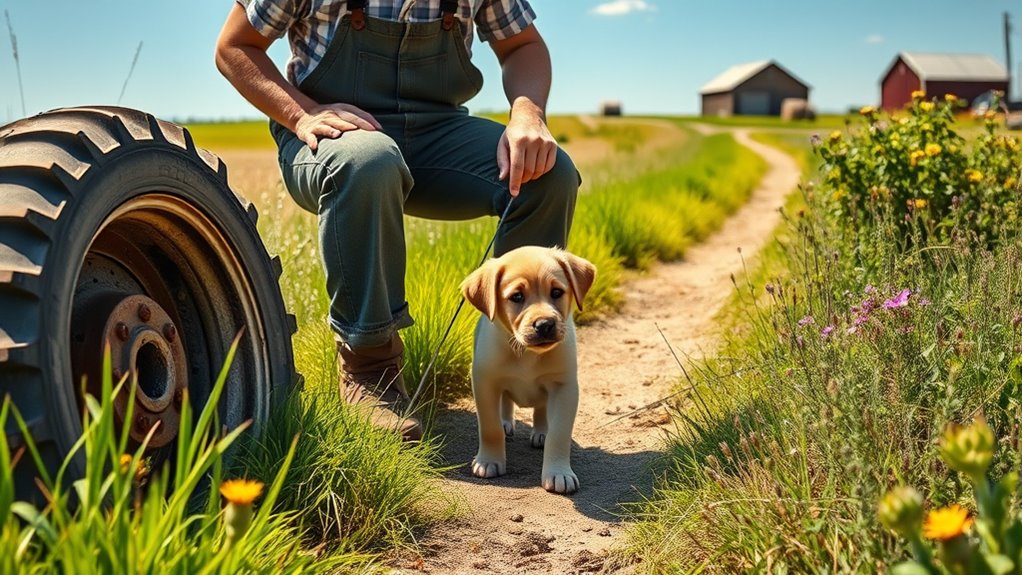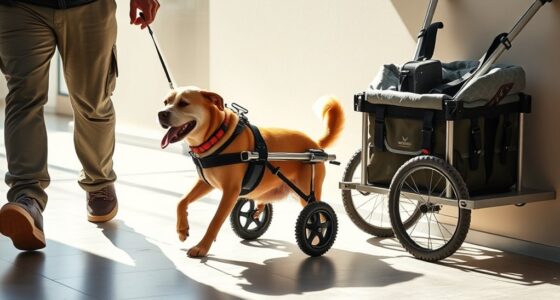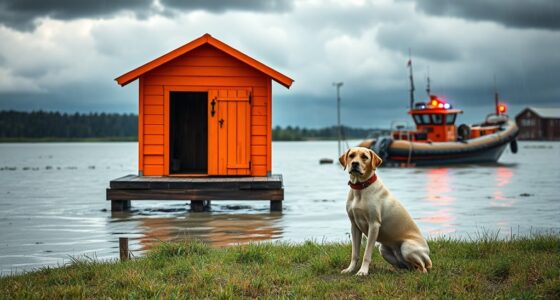To train your dog for farm life and hazard avoidance, start with reliable obedience commands like “leave it” and “come” to control their actions around dangers. Socialize your dog gradually with livestock, machinery, and farm visitors to reduce fear and aggression. Use positive reinforcement and consistent routines to reinforce safe behavior. Creating safe zones and practicing in various environments helps your dog stay calm and aware of hazards. Keep exploring these strategies to better prepare your dog for farm safety.
Key Takeaways
- Teach reliable commands like “leave it” and “stay” to prevent dogs from approaching hazards or dangerous animals.
- Gradually expose dogs to farm hazards, such as machinery or livestock, in controlled environments to reduce fear and reactive behaviors.
- Use positive reinforcement to encourage safe behaviors around risky areas or objects on the farm.
- Set up safe zones where dogs can retreat if they feel overwhelmed or threatened by hazards.
- Regularly monitor and reinforce hazard awareness training to ensure consistent safety responses in various farm situations.

Training your dog for farm life requires patience and consistency, but it’s essential for ensuring your dog can handle the unique demands of the environment. One of the first steps you should focus on is teaching your dog obedience commands. These commands form the foundation for safety and effective communication, especially in a busy farm setting. Commands like “come,” “stay,” “heel,” and “leave it” are vital. When your dog responds reliably to these commands, you can better prevent accidents or dangerous situations, such as chasing after livestock or wandering into hazardous areas. Practice these commands daily in various settings to reinforce learning and build your dog’s confidence. Using positive reinforcement, like treats or praise, helps your dog associate obedience with good things and speeds up the learning process.
Alongside obedience training, socialization techniques are equally important. On a farm, your dog will encounter a variety of animals, machinery, and unfamiliar people. Proper socialization helps your dog remain calm and confident in these situations, reducing the risk of fear-based reactions or aggression. Start by gradually exposing your dog to different farm environments, animals, and sounds in a controlled manner. Reward calm behavior and avoid overwhelming your dog with too much too soon. Regularly introducing your dog to livestock, such as cows or chickens, helps them understand boundaries and reduces the likelihood of chasing or startling the animals. Socialization also involves exposing your dog to other farm workers and visitors, so they learn to remain relaxed around new people and situations. Additionally, understanding projector technology can help in setting up a safe and engaging environment for training sessions indoors or outdoors. Incorporating vetted training methods ensures that your training approach is effective and humane, which is crucial for long-term success. Consistency and patience are also supported by understanding the importance of positive reinforcement in shaping desirable behaviors, making training more enjoyable and effective for your dog. Developing a clear understanding of dog behavior can further enhance your training effectiveness and improve your ability to interpret your dog’s needs and signals. Moreover, applying home improvement techniques such as creating safe zones or designated areas can provide your dog with secure spaces, reducing stress and supporting training efforts.
Remember, the goal is to create a well-rounded dog that responds reliably to commands and navigates farm life confidently. By combining obedience commands with effective socialization techniques, you’re giving your dog the tools they need to avoid hazards and thrive in this unique environment. With time, patience, and persistent effort, your dog will become a trusted helper on your farm, capable of handling the challenges that come with rural life.
Frequently Asked Questions
How Long Does It Typically Take to Train a Dog for Farm Hazards?
The training duration for hazard recognition varies depending on your dog’s age, breed, and previous experience. Typically, it takes several weeks to a few months of consistent training to effectively prepare your dog for farm hazards. You should focus on daily, short training sessions to reinforce safety cues. Patience and repetition are key, as regular practice helps your dog develop the skills needed to identify and avoid farm hazards confidently.
What Are Signs of a Dog Not Responding to Hazard Training?
When your dog doesn’t respond to hazard training, look for behavioral cues like hesitation, distraction, or ignoring commands. These signs show they might not fully understand or be comfortable with the hazards. Consistent training helps reinforce lessons, so if responses vary, it indicates the training isn’t sticking. Keep practicing, stay patient, and observe your dog’s cues closely to guarantee they learn to avoid hazards effectively.
Can Older Dogs Be Effectively Trained for Farm Hazard Avoidance?
Older dogs can be effectively trained for farm hazard avoidance, though age-related training challenges may arise. Your senior dog’s motivation might be lower, but patience and positive reinforcement help overcome this. Focus on short, consistent sessions and reward progress. With dedication, you can teach your older dog to recognize and avoid hazards, making farm life safer for both of you. Remember, their experience can aid in faster learning despite age.
What Should I Do if My Dog Ignores Safety Commands?
If your dog ignores safety commands, it’s like trying to steer a ship through a storm without a compass. Reinforce safety commands consistently, turning them into the lighthouses guiding your pup. Use positive behavior incentives to make safe actions rewarding, like a treasure chest of treats. Patience and persistent safety command reinforcement will help your dog see the importance, anchoring good habits firmly in their mind.
Are There Specific Breeds Better Suited for Farm Hazard Training?
Certain breeds are better suited for farm hazard training because of their temperament and intelligence. For example, Border Collies and Australian Shepherds tend to excel due to their high trainability and alertness, making training challenges easier to overcome. However, breed suitability varies, so you should consider your dog’s individual personality and energy level. With consistent training, most breeds can learn to avoid hazards effectively, regardless of their initial predispositions.
Conclusion
Training your dog for farm life is essential for safety and harmony. By teaching them hazard avoidance, you reduce accidents and ensure they’re a helpful part of your farm. Did you know that according to recent studies, properly trained farm dogs are 50% less likely to encounter dangerous situations? Keep training consistent and positive, and your dog will thrive alongside your farm activities. With patience, you’ll have a reliable, safe companion ready for farm life.










